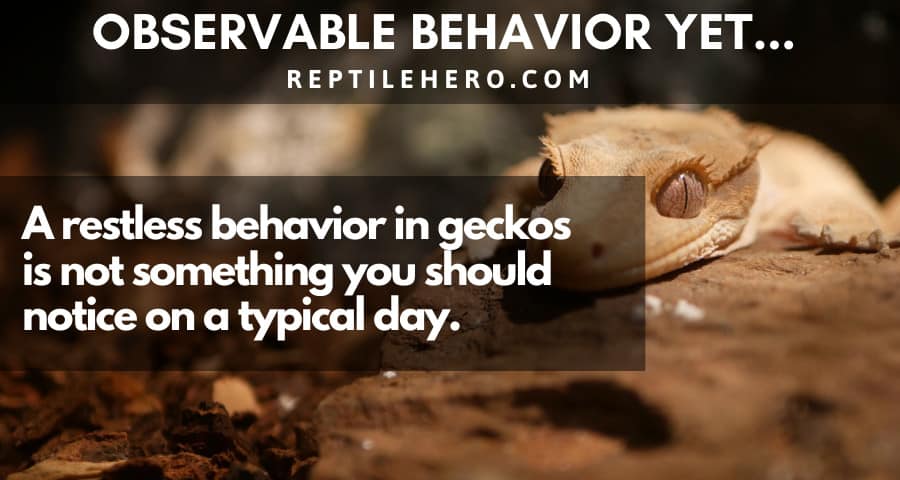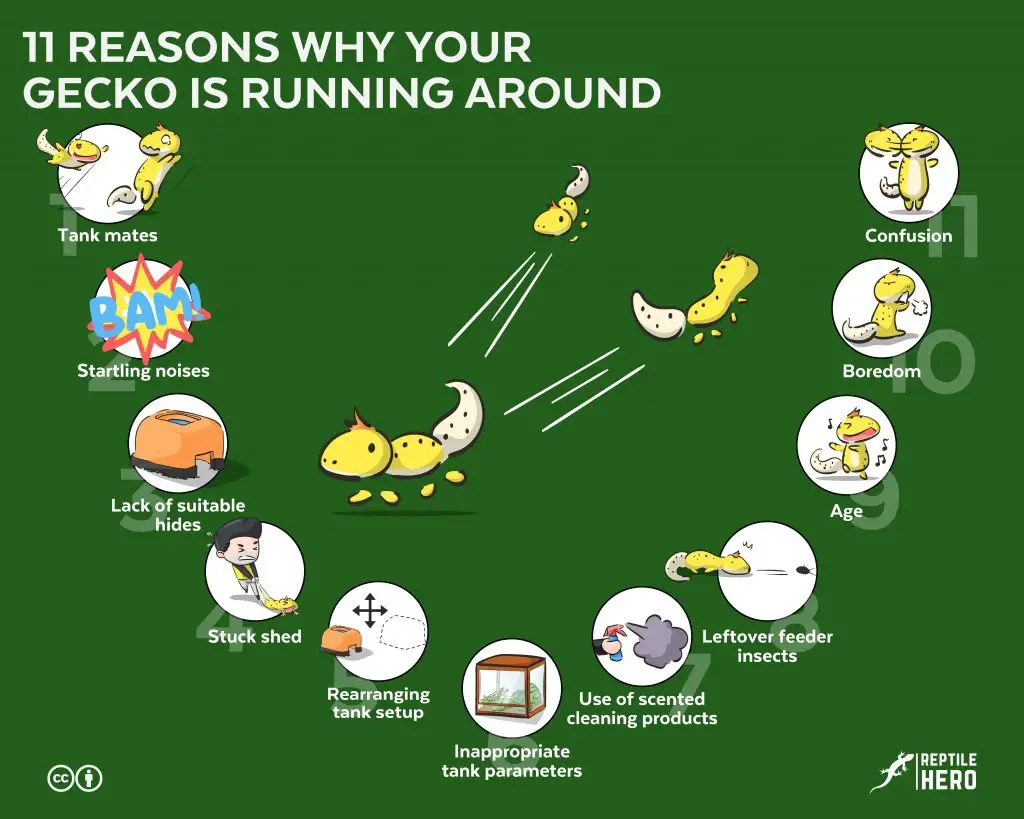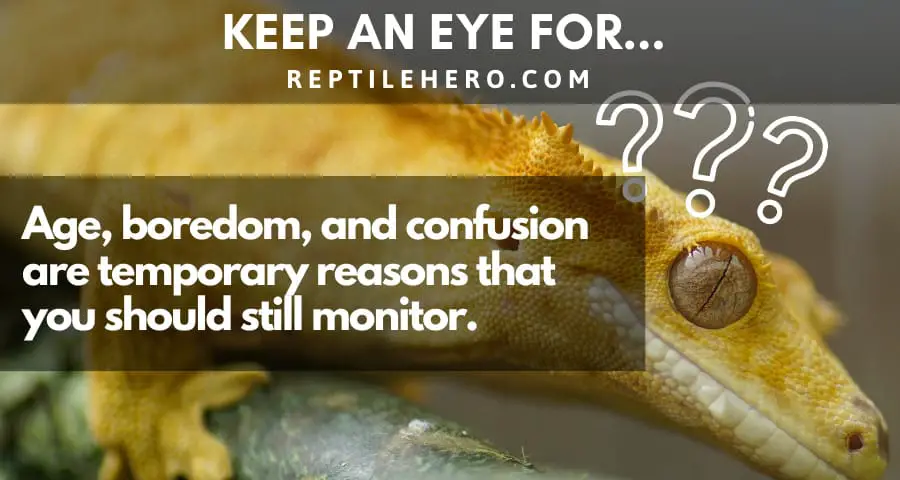Why is Your Gecko Running Around? The 11 Reasons
When I have a vacant time, I often observe my gecko inside its enclosure to entertain myself. However, there are times that I see my gecko frantically move around the tank, making me worry!
Geckos run around the tank for various reasons. Stress-related ones are due to 1) leftover food, 2) improper parameters, 3) inadequate hides, 4) cleaning products’ scent, 5) tank rearrangement, 6) startling noises, 7) stuck shed, and 8) tank mates. Other nonstress-related reasons are 1) age, 2) boredom, and 3) confusion.
After looking it up and reading about such strange action, did you know that geckos run around for a reason? Keep on reading to learn the possible triggers of this unusual action.
11 Reasons Why Your Gecko is Running Around
Reptiles, such as leopard and crested geckos, have limited means of communication. You would rarely hear them use vocal sounds. In fact, they heavily depend on body language and behaviors like licking and yawning to tell you something.
Running back and forth the tank is another behavior many gecko owners like me have observed.

8 Stress-related Reasons
For the most part, highly stressed geckos frantically run around the tank due to
1. Leftover feeder insects
2. Inappropriate tank parameters
3. Lack of suitable hides
4. Use of scented cleaning products
5. Rearranging tank setup
6. Startling noises
7. Stuck shed
8. Tank mates
In case you notice your pet acting strange like this, you have to find out which of the following eight reasons apply to your situation to take the appropriate corrective action.

1. Leftover Feeder Insects
Geckos may frantically run around the enclosure because of the presence of uneaten feeder insects.
Recalling one of my mistakes when I was new to the hobby, I had this wrong impression that giving extra feeder insects was a must for the gecko’s future consumption. While it did serve its purpose as a backup food, it was this time when I first noticed my gecko acting strange.
Dashing from one wall of the enclosure to the other, my gecko seemed like running a marathon. Until I saw a cricket hopping from a crevice, it dawned on me that something must be causing its distress. So, I started to ask around. “Should I leave uneaten feeder insects inside the tank?”
Fortunately, I was corrected by my friends with this simple advice, “Give only the number of feeder insects your gecko can eat in one sitting. That is, within three to five minutes of a feeding session.” However, while the statement does hold true, I realized that it is a bit lacking. As a result, many new reptile owners may misinterpret it.
In reality, owners must not only give the appropriate number of feeder insects. Instead, they should also supervise their geckos while eating in one sitting.
| Gecko Age | Number of Insects |
|---|---|
| Baby, Juvenile, and Adult | two insects for every inch of body length |
Again, the table above is only a guideline you can use as a starting point. Always make proper adjustments when necessary and according to your gecko’s needs. By following the revised advice, you prevent your gecko from running around because of leftover feeder insects that it could be hunting or avoiding.
2. Inappropriate Tank Parameters
Geckos may run around the tank when owners house them inside a vivarium with inappropriate parameter conditions.
The vivarium you would provide your gecko will be its forever home under your care. Nonetheless, anything inside the enclosure must be essential for its convenient living. However, even with my fuss for details, there can be moments when my crested or leopard gecko is acting strange—i.e., running around the tank to relay its stress.
Throughout my gecko-keeping journey, my geckos would dart from one end to the other when tank conditions and parameters were not met. For instance, the tank size or orientation was not suitable for their age. Otherwise, the temperature on the warm side of the tank was out of their tolerable range. Or the overall enclosure humidity was unmanageable.
So, let me ask you these.
- How big is the vivarium you bought? Is the tank’s orientation appropriate for the gecko’s preference?
- How do you measure the tank’s temperature and humidity? Do you know the exact values of the two?
Hearing the simple questions above may sound insulting on your end. In addition, knowing that you did your homework as a reptile parent, you must have recreated a proper vivarium for your gecko using the table below.
| Parameters | Leopard Gecko | Crested Gecko |
|---|---|---|
| Tank Size | > 20 gallons (adult) > 10 gallons (juvenile) | > 20 gallons (adult) > 10 gallons (juvenile) |
| Tank Orientation | Landscape(prioritize floor space) | Portrait(prioritize tank height) |
| Temperature | < 95°F (warm side) 78 – 88°F (cool side) | 75 – 82°F (warm side) 68 – 75°F (cool side) |
| Humidity | 30 – 40% | 60 – 80% |
However, there can be inevitable hurdles and mistakes that might hinder you along the way to producing the enclosure you had in mind. Thus, the answers to the queries may not be as common knowledge as you think. And they may need advanced thinking or improvised solutions to fully resolve, such as
- Instead of buying a 10-gallon tank for your juvenile gecko, you can opt for at least a 20-gallon tank. Since your gecko will grow into an adult, doing this can refrain you from multiple tank purchases.
- Opting for a high-quality thermostat to read your tank temperature and humidity may be more practical than getting the substandard ones.
3. Lack of Suitable Hides
Since geckos do not like open spaces, an enclosure with inadequate accessories and shelter may often spook them. This prompts them to frantically run around the tank.
Imagine you are living in a house with see-through walls and no curtains. I bet you would feel uncomfortable and vulnerable. Similarly, when you decorate a bare vivarium for your gecko, it would feel unsafe and exposed to the environment.
Insufficient hiding places make your gecko excessively skittish, which explains the frantic moving around its enclosure. I should say that the scarce covering makes them on high alert, knowing that predators could pounce them any moment. After all, they are more of prey than a predator in the wild.
As a result, they instinctively take refuge under large objects even in captivity. That is why, when I am putting up a new vivarium for a recently adopted gecko, I would add at least a total of three hides:
- Warm side: A hide that raises the gecko’s body temperature to aid digestion.
- Middle area: A relatively enclosed hide that should be humid for shedding.
- Cool side: A hide that lowers the gecko’s body temperature to cool itself.
Apart from the essential hides, I also add accessories to my liking. Indeed, you can add yours at your disposal. Some objects you can scatter all over your gecko’s enclosure include a handful of foliage, such as safe plants and woods.
To a greater extent, many owners might have overlooked this idea just like me! But another way you can incorporate to create a more secured habitat for your gecko is by overlaying the back and sides of the tank. I found wallpaper and vinyl stickers to get the job done.
4. Use of Scented Cleaning Products
Strong-scented cleaning products could irritate the geckos’ respiratory tract. Hence, geckos may run around their tank after an enclosure has been maintained and tidied up.
Once in a while, we conduct a routine clean-up to prevent the build-up of pathogens inside their tank. Yet there are times when we undeniably get into the mood of scrubbing and rinsing that we overlook the products we use!
Perhaps, you might have used any of the following? Cleaners such as
- bleach and strong acids
- chemical cleaners with pine scent
- cleaning products with phenols
Unfortunately, if these products ring a bell to you, you have to keep your hands off them!
First of all, using these heavily scented chemicals to cleanse the tank could stress your gecko beyond its wits. Especially when used to rinse the enclosure walls, they may leave a long-lasting after-odor. As a result, it would run amok to find a space with a breathable atmosphere.
In addition, a cleansed tank would remove all the familiar scents your gecko has marked it with. Essentially, your gecko would feel like it is in a new environment upon replacement. Thus, it may sprint from one side to the other to find any familiar scent.
Then again, cleaning the tank is a must to maintain a pathogen-free home for your geckos. However, the fear of using strong chemicals should not stop you from doing.
So, an alternative—such as chlorhexidine—should help your dilemma. It is an all-purpose cleaning product that is an equally effective disinfectant but is a lot safer for use in gecko tanks.
5. Rearranging Tank Setup
Switching around the hides and decorations inside the tank may cause geckos to act strange, such as running back and forth the enclosure.
While we are at it, cleaning the tank is often followed by overhauling the original setup. Say we add the new accessories we found at a nearby pet supplies store and remove the worn-out ones our geckos used to love.
Even though your intention of redesigning the tank meant no harm, unfortunately, your geckos can already get distressed over these small changes. After all, they tremendously rely on their sense of smell and limited memory. When we do a tank remodeling, it significantly takes off a lot of your buddy’s odor in the vivarium.
So, if you have ever done a total makeover, your gecko starts acting strange, you have to keep your calm. This restlessness is not something so serious as it can be temporary.
As for what you can do, there is pretty nothing much anymore than waiting until your gecko has settled down. Especially if you have already cleared up all the decorations with safe disinfectants, your gecko is already confused why things do not smell familiar.
When the gecko has finished remarking the place with its scent, its frantic running around the tank should subside. Typically, the strange action may last a day or two.
6. Startling Noises
Geckos have an exceptional sound reception. Hence, sudden clamors and loud sounds easily startle them, provoking a run around the enclosure.
I frequently hear several reptile parents complain about scurrying geckos inside the tank, oblivious of the underlying reason. Yet the cause may not be concealed after all. If you can be more attentive, you might know what it could be.
“Could it be that something is spooking my little reptile that I am unaware of?”
What are Noises to Avoid?
With their keen sense of hearing, geckos are stressed over startling noises. Hence, they frantically move around the tank.
Knowing that geckos are sensitive even to the slightest of murmur, I always see that I set up their enclosures in the quietest area of the house. However, even in the stillest corner, the tank is still susceptible to a cacophony of reverberating noises.
Generally, these sounds are characterized as (very) loud and sudden.
(Very) loud: Some examples include musical instruments, sirens, speakers, and thunderstorms. These noises may not be deafening to us. However, they can be blaring to geckos.
Sudden: To name a few, bangs, clunks, crashes, shrieks, thumps, and thuds are a few of the surprising noises that can startle us and especially the geckos when made within their proximity.
Even if your gecko hears startling noises daily, it will never get used to them like most of us do. While you can never avoid inevitable ones, you can devise a workaround to solve this problem.
That is, you can soundproof the area where the tank is situated. By doing so, the noise should be less impactful on the gecko. Thus, it can be an effective way to lessen its frantic running around the tank.
Otherwise, an anxious gecko may not only exhibit a strange action like frantically moving around the enclosure. But also, it can develop physical and mental health issues that you do not want to deal with.
What are Tolerable Sounds?
Due to their sensitive hearing, geckos can also get stressed over everyday noises, resulting in a run around the tank. However, this can be a temporary behavior as they can tolerate these safe sounds over time.
Unlike unbearable startling noises, safe sounds are the total opposite—not (very) loud or sudden. Thus, geckos would not necessarily have a problem with them. What can be considered safe sounds are those you would often hear daily, such as:
- door sounds
- dishwasher
- cellular and telephone
- radio and television
- vacuum cleaner
- washing machines
Most leopard and crested geckos may not be happy with these sounds at the start. That is why you might notice your buddy sprint once you open the door.
However, they will eventually get accustomed to slow and repetitive exposure to such noises. So, once your geckos become comfortable with the whirring of the washing machine, they could just sleep through your laundry session, unbothered.
7. Stuck Shed
When a gecko has a stuck shed, running around the tank can be one of its methods to remove the piled-up skin.
Due to lack of a well-balanced meal and poor husbandry, many geckos sustain a temporary stuck shed at some point in their life in captivity. However, the problem can turn sour once neglected by the owner.
Aside from the apparent visual cues of a premature, retained, or excessive shedding, other manifestations you can observe are a change in behavior to alleviate the discomfort. This comprises frequent rubbing on rough surfaces and running around the tank.
Since frantically moving around the tank is secondary to the issue, you initially have to address the root cause—stuck shed. Once you have done so, your gecko should stop darting from one glass wall to the other.
8. Tank Mates
In general, cohabitating geckos in one tank is not recommended due to geckos’ territorial behavior. The insurgence of aggressiveness might cause them to bully one another, resulting in one running around the tank.
Most reptiles—including most gecko species—actively avoid each other in the wild. Hence, we should respect this and never place two or more geckos together, whether of the same or opposite sexes.
After all, leopard and crested geckos are not social lizards. So, they do not need to live with others under your care in captivity. Unless you are breeding, you should avoid the improper practice.
One of the Few Exceptions
Social gecko species living in groups may run around the tank when a submissive is bullied by the dominant.
“So, why include the tank mates?” you might ask. Well, some of you could have geckos that can live in a community. Say, mourning geckos (Lepidodactylus lugubris) [1][2], one of the few social reptiles. So, this can come in handy!
As a particular case, seeing one of your geckos running around the tank can be due to its tank mates. Each of your geckos has its unique personality, just like us. It just so happens that one turns out to be a bully to the other.
Thus, the bullied will resort to dashing back and forth in their enclosure to escape their thug tank mate.
When it happens, you should take this sign seriously. Any indication of inconvenience with the environment and discomfort on your geckos can severely affect their physical and mental health.
You can take these steps as a countermeasure:
- Make sure to clear the other reasons.
- Identify the bullied and the bully.
- Check for any wounds and injuries in both geckos.
- Bring to the exotic vet when necessary.
- Set up another tank for the bully.
- Separate the bully from then on.
If you have inadequate resources to have more than one vivarium, you can separate them only for the time being. Then, you can follow these simplified steps after quarantining the bully for three to five days:
- Create a neutral ground for the two geckos.
- Put them on neutral ground.
- Observe their behaviors.
- Continue the observation for a week.
- Separate them again when there is aggression.
- Continue the process until they are comfortable.
- Replace both geckos in the main tank.
Take note that the introduction procedure can take at least a week. So, you should spare some time to ensure full supervision and a safe process. Otherwise, you have to decide what would be the best for your bully and bullied.

3 Nonstress-related Reasons
Running around in geckos is not always connected to stress. Typically, three non-stress related reasons that may provoke geckos to sprint from one side of the tank to the other are
1. Age
2. Boredom
3. Confusion
If your gecko turns berserk but is not stressed, perhaps the three reasons below can help you remedy the issue.
1. Age
Owners may observe their geckos run around the tank at certain stages of the latter’s life. Specifically, geckos could exhibit episodic sprints during juvenile, adolescent, and mature.
Just like us who experience remarkable behavioral changes at different points in our lives, geckos may also face the same, offsetting such changes by running around the tank.
Juvenile. Baby and young ones are prone to become overwhelmed by all the new information they need to process. As part of exploring the new surroundings, they may aimlessly dash around the tank in their first few days.
Adolescent. When young geckos hit puberty, they can become fidgety (and even aggressive). They undergo a handful of changes due to energy and hormone surges. Hence, they may compensate for such by running around the tank.
Mature. Adult geckos are not excluded from this strange behavior. During the breeding season, they may have a higher impulse to break free and look for a mate. Thus, they would resort to frantically running around the tank.
Fortunately, when this happens to your gecko for this very reason, you just have to wait since it should resolve on its own once it has passed that phase in its life.
2. Boredom
Geckos living in a non-stimulating vivarium for more than a month may opt to run around the tank in hopes of getting out.
When I am out of household chores for the day, I watch Netflix or spend idle time with my cat. Yet apparently, doing this for more than a month would certainly bore me out! Either I could feel unexplainable exhaustion or agitation on what else to do.
So, imagine yourself in the place of your gecko. It would feel the same. As a result, it will definitely look for something more interesting. “How can we solve this?” you might ask!
Well, you can try some of the things below, which I found to be effective on my geckos:
- Add new accessories like rocks, branches, and woods.
- Allow it to hunt for its feeder insects.
- Do partial rearrangement on its tank once a week.
- Incorporate multipurpose and enriching hides.
- Try adding different foliage that is safe for geckos.
Periodic partial rearranging your gecko’s forever shelter would make it feel more comfortable and stimulated. Thus, you should notice a well-rested, less spastic, and more contented buddy.
3. Confusion
Without complete understanding, geckos may run straight to the glass walls of the tank, thinking that no invisible separation exists.
Many animals—including geckos—can not fully perceive what glass is. They are oblivious of the unnoticeable barrier dividing the inside and outside of the enclosure. Apart from this, what makes them frantically run around is the reflective ability of glass.
At certain angles of light, glass can generate your gecko’s reflection. When this happens, not only will it be confused with the presence of another gecko. It would also run away from the image to protect itself from the imaginary predator.
Although it is not too distressing for your gecko in rare instances, it can be once the circumstance persists. So, you might consider doing any of the following to eliminate or reduce reflections:
- Add decorations to the wall where there are reflections.
- Ensure that the tank’s room is well-lit.
- Layer the back and sides of the tank with white vinyl.
- Move the tank near a bright wall if possible.

Summary of Why Geckos Run Around
Generally, geckos do not unexpectedly run around the tank for no apparent reason. In fact, running back and forth is not part of their natural behavior.
Stress-related causes include 1) leftover food, 2) improper parameters, 3) inadequate hides, 4) cleaning products, 5) tank rearrangement, 6) startling noises, 7) stuck shed, and 8) tank mates. Immediate action should be taken as stress quickly worsens physical and mental health.
Meanwhile, non-stress related causes consist of 1) age, 2) boredom, and 3) confusion. Despite being generally harmless, these reasons should not be ignored. Appropriate actions must be conducted to resolve the problems.

![How Do Geckos Walk on Walls? [With Science]](https://www.reptilehero.com/wp-content/uploads/2021/10/G44_-_Redesign-768x614.jpg)
![Why Does Your Gecko Lick? [You, Themselves, and Other Objects]](https://www.reptilehero.com/wp-content/uploads/2021/05/gecko-lick-object-cc-768x614.jpg)
![Homemade Crested Gecko Food [10 Recipes]](https://www.reptilehero.com/wp-content/uploads/2021/05/G47-768x614.jpg)

![Are Christmas Trees Dangerous to Reptiles? [10 Risks & 21 Trees]](https://www.reptilehero.com/wp-content/uploads/2022/01/christmas-tree-pose-risk-reptile-cc-768x614.jpg)
![Can Your Gecko Eat Waxworms? [3 Things You Must Know]](https://www.reptilehero.com/wp-content/uploads/2021/06/Can-gecko-eat-waxworm-infographic-768x614.jpg)
